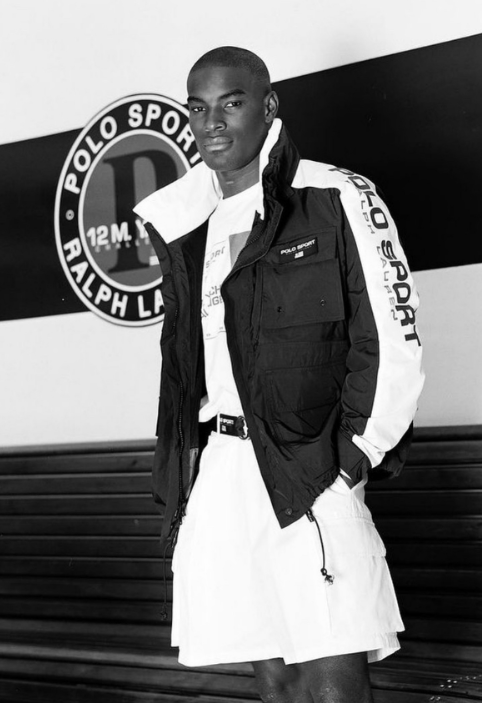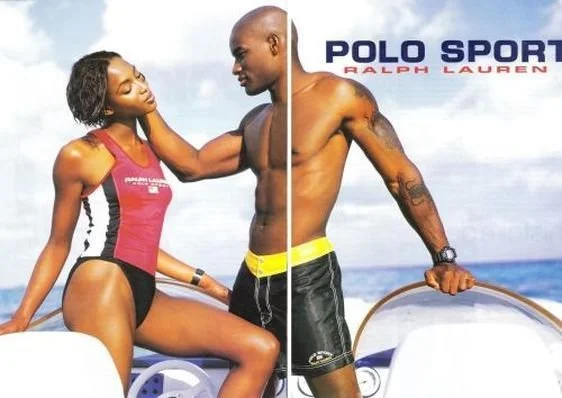JAMES JETER: Celebrating black roots
Growing up, half of my wardrobe was Polo—Polo tees, dresses, and even coats. To me and my family, Polo was luxury. I remember being jealous of the Polo collection my older brother had; his tees always felt just a little cooler. I also remember hating the Polo coat my mom made me wear—I was definitely giving ungrateful back then.
My relationship with the brand has always been a mix of love and hate. But after watching Very Ralph, the HBO documentary on Ralph Lauren, I began to understand the brand through his eyes. There’s a certain magic in building a world that reflects how you want your life to look—crafting identities, telling stories, and playing characters through clothing. I questioned whether there was enough diversity in that world. The Black community has long embraced Polo—rocking it head to toe, making it our own—but for a long time, we didn’t see ourselves represented in the brand’s campaigns or stories. That gap always stood out to me.
Ralph Lauren has moved from symbolic diversity to intentional inclusion, with storytelling that honors Black excellence, heritage, and American identity. Under creative leads like James Jeter, the brand is now actively reshaping its legacy.
Ralph Lauren & the Black Community
Ralph Lauren’s connection with the Black community, especially hip-hop and fashion, has a complicated but strong history, centered around the 1990s Polo trend in cities like New York. The brand’s image was about classic American life—polo players, yachts, and horses—not aimed at Black or urban buyers at first.
Credits For Photo: @thepoloarchive
“Lo Life” was the name adopted by a group of young people from Brooklyn in the 1980s who had an obsession with all things Ralph Lauren. They would meet up—sometimes two or three times a day—to “boost” Polo pieces from department stores, either to sell or keep for themselves. They only went outside when wearing full Ralph Lauren outfits, making luxury fashion a strong street style.
1990s: Tyson Beckford
In 1993, Tyson Beckford became one of the first major Black male models to lead campaigns for Polo Ralph Lauren. Discovered by Ralph Lauren’s team, he quickly rose to the top as the face of Polo Sport, making history as one of the first Black male supermodels to front a major fashion campaign. Beckford’s look—masculine, athletic, and clean-cut—not only aligned with Ralph Lauren’s classic aesthetic but also helped expand the brand’s cultural reach. His success marked a turning point, creating a new era of male modeling and increased visibility for Black men in high fashion.
While Ralph Lauren began to show more diversity in the 2000s, Black models were still rarely at the forefront of its major campaigns. The brand continued to center its marketing around a traditional American lifestyle—one often associated with whiteness, wealth, and exclusivity.
"I represented more than just fashion—I was a statement that Black men belonged in this world of elegance and aspiration." – Tyson
From Stockroom to Studio
James Jeter, a 2013 graduate of Morehouse College, began his journey with Ralph Lauren at just 16 years old, working as a part-time sales associate at the Rugby store in Georgetown. He transitioned to the design side of the company in 2013 as a Concept Design Intern and quickly rose through the ranks.
Over the years, Jeter held several key roles, including Design Associate, Concept Designer, and Director of Concept Design and Special Projects. In 2024, Jeter made history when he was named Creative Director of Design & Brand Direction for Men’s Polo, becoming the first Black person to ever hold that title in Ralph Lauren’s 57-year history.
Noteworthy Collections Curated by Jeter
Morehouse & Spelman Colleges Collection
Co-created with Dara Douglas, this HBCU-inspired capsule collection marked a historic moment for Ralph Lauren—it was the brand’s first campaign led by an all-Black creative team and cast, directly challenging its traditionally Ivy League image. Drawing inspiration from 1930s to 1950s collegiate style, the collection featured timeless pieces like varsity jackets, crisp white dresses, and classic knit sweaters.
James Jeter sought to reclaim these iconic garments—such as three-piece suits and circle skirts—through a more inclusive lens. Debuted during New York Fashion Week, the collection not only celebrated Black academic excellence but also revitalized Ralph Lauren’s connection with young Black consumers.
Oak Bluffs Collection
Building on the success of his HBCU-inspired work, James Jeter led the creation of the "Polo Ralph Lauren for Oak Bluffs" collection—an homage to the rich African American heritage of Oak Bluffs, a historic community on Martha’s Vineyard. This limited-edition line features twill jackets, sailor-inspired knits, varsity cardigans, and baseball caps. To keep it authentic, the collection was designed with HBCU alumni who shared their real experiences and history.
To launch the collection, Ralph Lauren produced a campaign, directed by Cole Brown and photographed by Nadine Ijewere. The campaign included a short documentary, A Portrait of the American Dream: Oak Bluffs, which premiered at the 2025 Martha’s Vineyard African American Film Festival.
It’s not just that James Jeter is part of the brand—he’s helping write the narrative. For years, Black communities have embraced Ralph Lauren, turning its high-class style into a symbol of street pride and luxury. From Brooklyn’s Lo-Lifes in the ’90s to global rappers and trendsetters, Polo has been a key part of Black fashion. Yet, until recently, those designing the brand rarely reflected its Black fans.
Did James Jeter come correct with his Collections as Creative Director and Design director for Polo Ralph Lauren?






